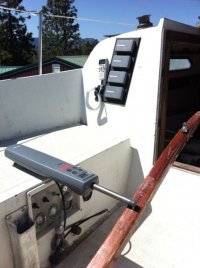G'day E Owners,
the other woman, 'Merrimist', my 86' E38 has the original Datamarine sail instruments, Log, Wind speed, wind angle and Depth gauges fitted into the cockpit port side fwd of companionway, Depth being the only one working fitted. All accessible through a nice little cupboard door at entry to port aft cabin.
A PO has fitted a ST4000 wheel Autopilot that although powers up and works, seemingly and randomly, I might add, has a mind and course of its own when you are not paying attention. This is after having completed 360 deg calibration set ups........ but thats another story.
Also fitted is a Raytheon RL70 Chart Plotter and Raytheon 2kw radar along with Loran C, none of which are fit for purpose - although power up and work, plan to throw out or give to maritime museum......
So, I have happily made the executive decision that it all has to go.
Am again reaching out asking other owners about their experience and or recommendations for new electronics, of what has worked, or just as important, has not worked for them on same or similar size boats. As my recent post about new sails notes, I am planning to do some blue water and coastal cruising.
So along with a new planned purchase of sail wardrobe, I am also shopping for new full/complete Electronics/Sail instruments upgrade.
I am considering the following bits of kits to purchase and fit:
Chartplotter/GPS/Radar (4kW),
DSC/AIS ("B' receive only)/VHS radio with remote for helm,
Autopilot,
Full set of wind instruments including Vessel speed/SOG, TWS/AWS, TWA/AWA, depth/temp, etc.
Am thinking all NMEA2000 and WIFI compatible. i.e.backup iPad for chart plotter. I already have and am very happy with my handheld Garmin GPS70SC.
So with the exception of the iCom VHF/DSC/AIS radio, I am seriously considering where possible all 'Garmin' kit
All Garmin gear priced at WM earlier this month, for about 6.5k, which I think is acceptable.
WM are also now doing price matching. For ex. if items were to be cheaper from say Defender, WM would match or better the price.....
Look forward to comments, on other experience/s, on what works/did not work, ease or difficulty of installation, recommendations on manufactures Raymarine v Garmin v Lowrance v other, etc.
With regards to AIS, given I am planning both coastal and blue water cruising, clearly class A AIS has safety advantages, but with that comes increased costs and certs.
What would you recommend, AIS A or B?
One other question I would like to ask is, can anyone recommend boat yard on east coast where they have had good, safe, reasonably fair experiences I can carry out these and planned upgrades between April and June next year.
A yard that has experience to remove and step the mast, a cleanish - no dust bowls, yard that can haul and store the boat (security) whilst I carry out my exciting upgrades to my other woman.
Hammy
Engineer
SY Artemis
the other woman, 'Merrimist', my 86' E38 has the original Datamarine sail instruments, Log, Wind speed, wind angle and Depth gauges fitted into the cockpit port side fwd of companionway, Depth being the only one working fitted. All accessible through a nice little cupboard door at entry to port aft cabin.
A PO has fitted a ST4000 wheel Autopilot that although powers up and works, seemingly and randomly, I might add, has a mind and course of its own when you are not paying attention. This is after having completed 360 deg calibration set ups........ but thats another story.
Also fitted is a Raytheon RL70 Chart Plotter and Raytheon 2kw radar along with Loran C, none of which are fit for purpose - although power up and work, plan to throw out or give to maritime museum......
So, I have happily made the executive decision that it all has to go.
Am again reaching out asking other owners about their experience and or recommendations for new electronics, of what has worked, or just as important, has not worked for them on same or similar size boats. As my recent post about new sails notes, I am planning to do some blue water and coastal cruising.
So along with a new planned purchase of sail wardrobe, I am also shopping for new full/complete Electronics/Sail instruments upgrade.
I am considering the following bits of kits to purchase and fit:
Chartplotter/GPS/Radar (4kW),
DSC/AIS ("B' receive only)/VHS radio with remote for helm,
Autopilot,
Full set of wind instruments including Vessel speed/SOG, TWS/AWS, TWA/AWA, depth/temp, etc.
Am thinking all NMEA2000 and WIFI compatible. i.e.backup iPad for chart plotter. I already have and am very happy with my handheld Garmin GPS70SC.
So with the exception of the iCom VHF/DSC/AIS radio, I am seriously considering where possible all 'Garmin' kit
All Garmin gear priced at WM earlier this month, for about 6.5k, which I think is acceptable.
WM are also now doing price matching. For ex. if items were to be cheaper from say Defender, WM would match or better the price.....
Look forward to comments, on other experience/s, on what works/did not work, ease or difficulty of installation, recommendations on manufactures Raymarine v Garmin v Lowrance v other, etc.
With regards to AIS, given I am planning both coastal and blue water cruising, clearly class A AIS has safety advantages, but with that comes increased costs and certs.
What would you recommend, AIS A or B?
One other question I would like to ask is, can anyone recommend boat yard on east coast where they have had good, safe, reasonably fair experiences I can carry out these and planned upgrades between April and June next year.
A yard that has experience to remove and step the mast, a cleanish - no dust bowls, yard that can haul and store the boat (security) whilst I carry out my exciting upgrades to my other woman.
Hammy
Engineer
SY Artemis

